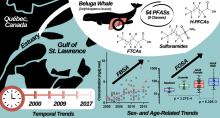| Title | Tissue distribution, maternal transfer, and age-related accumulation of dechloranes in Chinese sturgeon. |
| Publication Type | Journal Article |
| Year of Publication | 2012 |
| Authors | Peng, H, Zhang, K, Wan, Y, Hu, J |
| Journal | Environ Sci Technol |
| Volume | 46 |
| Issue | 18 |
| Pagination | 9907-13 |
| Date Published | 2012 Sep 18 |
| ISSN | 1520-5851 |
| Keywords | Animals, China, Eggs, Environmental Monitoring, Female, Fishes, Flame Retardants, Hydrocarbons, Chlorinated, Polycyclic Compounds, Tissue Distribution, Water Pollutants, Chemical |
| Abstract | While dechloranes have been detected in environmental media and wildlife, limited information was available on their tissue distribution in wildlife. Syn-dechlorane plus (syn-DP), anti-DP, syn-undecachloropentacyclooctadecadiene (syn-Cl(11)DP), anti-Cl(11)DP, dechlorane 602, dechlorane 603 and mirex were measured in 13 organs of 17 female Chinese sturgeon (Acipenser sinensis). Dechloranes were detected in all tissues and the highest concentrations of total dechloranes were detected in heart (87 pg/g ww, 4.5-645 pg/g ww), followed by adipose (61 pg/g ww, 14-531 pg/g ww) and eggs (57 pg/g ww, 13-261 pg/g ww). The tissue distribution of DP was mainly determined by lipid partition, while Dec 602 and Dec 603 preferred to accumulate in the intestine and stomach. The values of f(anti) (the concentration of anti-DP relative to the sum concentration of DP) in maternal tissues (0.72 ± 0.03 in muscle) were significantly higher than those found in eggs (0.65 ± 0.04) (p < 0.001), while f(anti-Cl11DP) (the concentration of anti-Cl(11)DP relative to the sum concentration of Cl(11)DP) in maternal tissues (0.59 ± 0.10 in muscle) was significantly lower than that in eggs (0.75 ± 0.13) (p < 0.05). High maternal transfer efficiencies of dechloranes were observed in eggs, which accounted for 49% of the total body burden, and the ratios of concentrations in eggs to maternal tissues (EMR) for mirex, Dec 602, Dec 603, syn-Cl(11)DP, anti-Cl(11)DP, syn-DP, and anti-DP were 18, 8.8, 5.2, 2.6, 5.2, 5.5 and 3.7, respectively, which are dependent on their K(OW) values (r = -0.66, p < 0.01). Negative age-related trends were observed for mirex, Dec 603, syn-Cl(11)DP and anti-Cl(11)DP in eggs (R(2) = 0.28-0.38, p = 0.02-0.05), which were possibly due to their high transfer efficiencies to eggs from maternal body (49%). |
| DOI | 10.1021/es3025879 |
| Alternate Journal | Environ. Sci. Technol. |
| PubMed ID | 22913883 |
Environmental Chemical Biology

